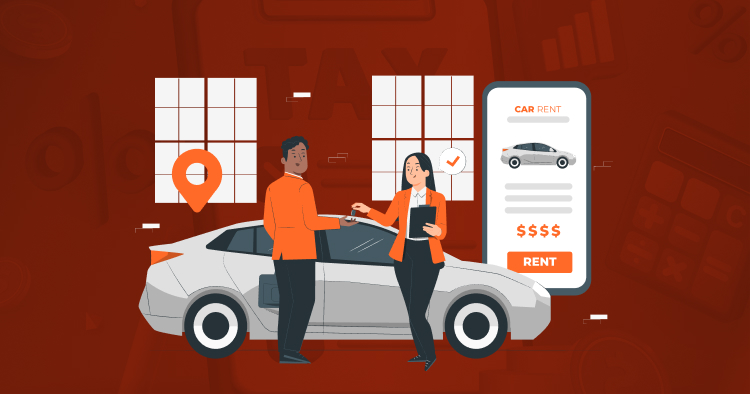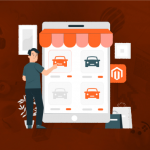Magento Car Website Design: How to Create a Stunning Car Dealer Portal?
Last Updated | July 4, 2023
Table of Contents
Magento Car Website Design
Keeping your motors revving with automotive eCommerce solutions
The management and understanding of numerous different automobile models, manufacturers, and parts can result in millions of options in the automotive industry. Customers, however, demand an easy-to-use, seamless automobile eCommerce platform. Magento is the right platform for all your Car Website Design.
Why Magento Car Website Design?
- The Ideal Fitting
By linking several databases and providing product variables that speed up product searches, you may make it simple for customers to find the right car components. Discover more from our Automotive-focused Solution Partners.
- Under The Hood-Mobile
Customers may use their mobile devices to discover the right car components and make payments thanks to Magento. For a flawless shopping experience, process payments more quickly and provide customers with mobile access.
- Complete Relationship Information
With a solid integration between databases and inventory management, you can provide reliable, real-time customers with information. Utilize our fully – featured automotive eCommerce platform to manage challenging routing and integrations.
- Demystify complicated goods
By offering bespoke “fit my car” features, you may simplify complex product selections for your consumer. They can easily be guided through options that are ideal for the brand, manufacturer, and the year of their car.
What Is Magento?
A content management system called Magento was developed mainly for medium- and large-sized e-commerce firms, where you’ll get as much automation, flexibility, and functionality as you can get.
A versatile shopping cart system, and also autonomy over the design, content, and functioning of their online storefront, are all features of Magento, an e-commerce platform built on open-source technology. Magento provides robust capabilities for catalogue management, SEO, and marketing.
There are three different Magento versions;
Magento Open Source is the most widely used version of Magento, which would be available for free. The majority of eCommerce business owners can use Community because it offers so many wonderful features.
Their hosted option, Magento Commerce, is comparable to one made available by the well-known e-commerce platform Shopify. Smaller retailers are better suited for Magento Commerce.
Magento Enterprise’s premium version gives enterprise-level sellers access to more functionality. Although quite pricey, this Magento version may not be the ideal choice for mid-level shops. The “big dudes” should choose this choice.
Without writing a single line of code, you may create a highly professional website for a car dealer.
The screenshot above should give you a decent idea of the design because the photos, colours, and text are all entirely adjustable.
You can build a stunning website that looks fantastic on laptops and mobile devices using the techniques described in this post.
Additionally, because it doesn’t create code, you can edit the website whenever you like.
How To Build A Stunning Portal For Car Dealership
Start the site’s development by launching a basic Magento website, and then add a Magento theme to give it more individuality.
The processes to establish a website for a car dealer are summarized as follows:
- Get a domain name
- Signup for hosting
- Get familiar with Magento
- Install a Magento theme
- Launch website
A domain name is the first thing you need, even before you consider learning Magento.
- Getting a domain name
A domain name is used for every website. Your brand should ideally be followed by.com.
Try adding a new phrase after your brand if you are unsuccessful in getting it accepted as a domain name. Put “dealer” or “cars” after the name of your company, for instance.
You can purchase hosting as soon as you’ve located an available domain.
- Get Web Hosting
For it to load and work, your website needs hosting.
You are effectively renting space on a server when you sign up for hosting. Your website’s primary cost will be this, however, there are several incredibly inexpensive choices available. For as little as $2.95 per month, Bluehost is an excellent choice for anyone building their first Magento website. A trustworthy firm to host is Bluehost. They perform well, and when you need it, the live chat assistance is helpful.
Kinsta, which we frequently use for this website, is what we would suggest if you really want a high-performance host. You might wish to start with Bluehost and switch once your website is lucrative because it has a much higher price tag.
Tutorial On How To Get Started with Magento
There are a few prerequisites you must meet before installing Magento:
The specifications listed in Magento System Requirements must be met by your system.
All requirements outlined in Prerequisites must be fulfilled.
You must change to the Magento file system owner after logging into the Magento server.
we’ll use “Magento Commerce” in our example of setting up a Magento store:
- Head over To Magento
Visit the Magento website and explore the area. Before setting up, there are many components and things to be aware of. Don’t worry if it’s over your head; it probably will be for the majority of folks as much of it is created for developers. Search for one of the ever-present links to a free trial of Magento Commerce when you’re ready to join up and launch your free trial!
- Managing Admins Page
You can access your store admin page by clicking on the helpful URL addresses provided in the confirmation email.
This will take you to the quick start wizard and store dashboard, which are the two apps you must learn to fully comprehend the platform. Your command center is here!
- Selecting The Hosting
Strong servers are needed because the Magento database is resource-intensive. Numerous businesses, including Nexcess and SiteGround, are focused on hosting Magento-powered web storefronts. Depending on how many stores you wish to run, the cost of hosting for Magento can range from $3.95 per month with Siteground to $114 per month.
- Choosing A Theme
The majority of stores employ their personal developers to create distinctive themes in line with their advertising strategy. Buying a pre-made theme from Themeforest and customizing it to suit your tastes would be a less expensive option.
Click “Save and Apply” in the menu bar to finish installing your theme.
- Customize Your Website Design
It’s time to customize your store to reflect your company’s brand now that it’s been set up. Drag your cursor over the “Design” menu item in the fast start wizard for your store. Click “Select & Customize Your Design” in the submenu that appears. This will reveal a brief window with instructions on how to use Magento themes.
The Theme Editor will open after you click Continue. From there, you may personalize and create your own storefront! As this process may be a little complicated, I once more advise seeking the advice and assistance of a developer.
- Adding Functionalities Using Extensions
Extensions for Magento are programs that you may put on the store to add extra features. On the Magento Connect page, Magento provides a large selection of extensions and add-ons, ranging in price from completely free to several hundred dollars. How much an extension can boost your potential revenue often determines the price? More value, therefore, equals more money.
- Setting Up Database
You will now establish the database, command center, and e-commerce “death star” after setting up your hosting, extensions, and theme. This can be configured on your administration page, where you can:
- retail name
- Contact email for notifications
- Shipping procedures
- Payment procedures
- services for email marketing
- Products
- types of goods
- Your installed extensions require more configuration.
- Start Adding The Products
You’re ready to fill your shelves with merchandise now that you’ve snazzed up the business with a design including all the details. Choose “Create New Products” from the “Products” menu.
You will then be prompted for an “Attribute Set” and a choice on the use of Complex Product Types. As you can update it later, leave the attribute’s default value in place.
You can list virtual items, gift cards, packaged products, configurable products, and grouped products using the Complex Product Types option. Leave this option deselected for now since we’ll only be adding a straightforward product.
And continue.
- Add Product Description
You will now be prompted to enter the product information. This, in my opinion, is the key component of a store’s setup. The accuracy of your product descriptions and photographs will ultimately determine whether or not your buyers choose to purchase the items.
Included in the details are:
Unique Product Names
Informative headings, SKU numbers, delivery specifics, weight and material make sizing or other pertinent business data
The “Status” and “Visibility” special product options let you choose whether the product is enabled (i.e., live) in your store and whether it should be discovered in the search bar, catalogs, in both, or in neither, respectively.
Click “Save and Continue Edit” when you are finished.
Mention PRICES And Add Images Of The Products
Click “Prices” in the left-hand menu to add a price to your product. Click “Save and Continue Edit” after filling out the mandatory fields, including the tax class.
Click “Images” in the left menu to add product images, then download them as you might for most web pages. The image you want to use as the basic image, tiny image, and thumbnail can then be chosen.
Then select “Save and Continue Editing.”
- Add SEO Optimized Keywords
Click “Meta Information” on the left menu. You can select the descriptions that will appear in search results, as well as include keywords for SEO, here. Although this is ANOTHER step, it’s crucial because it will help drive visitors to your website.
- Setting Up Shipping and Payments
Users have to set up shipping and payments otherwise your business won’t exist! You must click the “Start My Store” button in the upper left to configure these choices. Like other e-commerce platforms, it is a reasonably simple process.
- Let’s Get Launched
You might be amazed at how quickly you can get a respectable website live, even though a finished website can seem like a distant dream.
You may get a live Magento Car website design by simply following the first two stages of this article.
There are themes for every type of website you can think of now that Magento has been around for almost 14 years. Incredible capability is available, and the cost is really affordable. many times less expensive than hiring engineers to build the same functionality.
We sincerely hope that this advice opened your eyes and assisted you in building a stunner car dealer portal. If you liked it, please think about spreading the word before you leave.
FAQs for Car Website Design
Q. Is Magento a perfect eCommerce for Car Website Design?
A. Magento Development Services is the best eCommerce platform for launching your automobile business online for a variety of reasons.
- Turn on support for multiple stores and languages.
- Examine the Numerous Options in the Magento Marketplace
- Using UI Libraries and Highly Responsive Themes
- The Multi-Source Inventory Feature Enables Better Inventory Management
- Improved Mobile Features To Reach Wider Audiences
- Adaptive Pricing
You can also hire Magento 2 developers for your business needs with Folio3. Contact us now so that you can get started with your Magento Car website design within 32 hours.
Q. What is Magento 2 third-party API integration?
A. PIM (Product Information Management), ERP (Enterprise Resource Planning), CRM (Customer Relationship Management), and other third-party software systems are currently proven to be supported by the Magento 2 integration via API.
In relation to business management as well as the utilization of efficient sales and marketing data to reach the best performance, these linkages provide several advantages.
The Magento 2 web API is required to carry out the integration of third-party software and services.
Do you want to build an integration? You can read more in this official Magento lesson if you are familiar with programming on the Magento platform.
You might also let your Magento 2 developers use the program of your choosing.












